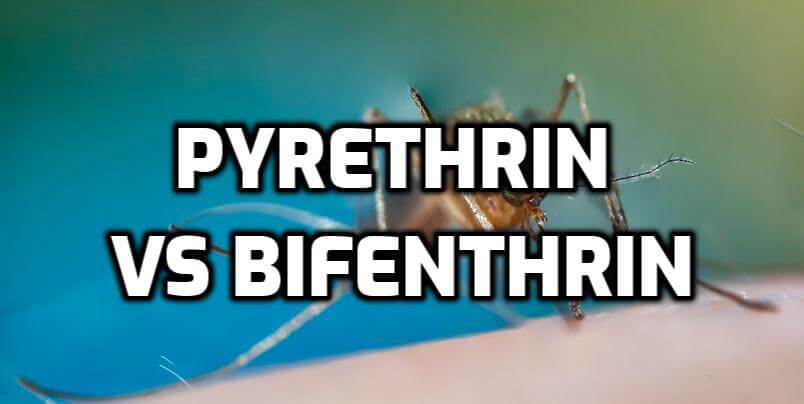Pyrethrin vs Bifenthrin for Mosquitoes

Mosquitoes are not just pesky insects; they are vectors of several dangerous diseases like dengue, malaria, and Zika virus. Therefore, controlling their populations and preventing bites is essential. Two commonly used insecticides for mosquito control are pyrethrin and bifenthrin.
Both are known for their efficacy, but they differ in many aspects. Here’s a comprehensive comparison to help you understand their uses, advantages, and disadvantages.
Pyrethrin vs Bifenthrin Table
This comparison table will help you understand the differences between Pyrethrin and Bifenthrin for mosquito control at a glance.
| Feature | Pyrethrin | Bifenthrin |
|---|---|---|
| Origin and Nature | Naturally occurring, derived from chrysanthemum flowers. | Synthetic, belongs to the pyrethroid class of chemicals. |
| Mode of Action | Targets insect’s nervous system, causing paralysis and death. | Disrupts the insect’s nervous system, similar to pyrethrins. |
| Advantages |
|
|
| Disadvantages |
|
|
| Ideal Usage | Short-term events like outdoor parties or camping due to rapid action and minimal environmental impact. | Protecting homes or large areas over extended periods due to its long-lasting residual effect. |
| Environmental Consideration | Biodegradable and breaks down quickly. | Less biodegradable and can accumulate in sediments. |
Short Review of Pyrethrin
Pyrethrins are naturally occurring compounds derived from the flowers of the chrysanthemum plant. Being organic, they are often perceived as eco-friendly and have been used in pest control for centuries.
Mode of Action
Pyrethrins target the nervous system of insects, leading to paralysis and eventual death. Due to their rapid action, they’re excellent for immediate knockdown of mosquitoes.
Advantages
- Rapid Action: Pyrethrins act fast and can knock down mosquitoes shortly after contact.
- Low Toxicity to Mammals: Given their natural origin, pyrethrins have a low toxicity profile for humans and pets, especially when used as directed.
- Biodegradable: Pyrethrins break down quickly in the environment, reducing the chances of long-term ecological impact.
Disadvantages
- Short Residual Activity: Their biodegradable nature also means they don’t last long. For continuous protection, frequent reapplication is necessary.
- Potential Allergens: Some individuals may develop allergies or experience irritation upon exposure.
Short Review of Bifenthrin
Bifenthrin belongs to the pyrethroid class of chemicals. Pyrethroids are synthetic derivatives of natural pyrethrins, designed to mimic their insecticidal properties but with enhanced stability and longevity.
Mode of Action
Like pyrethrins, bifenthrin disrupts the normal functioning of the insect’s nervous system. Its residual effect ensures that it continues to control pests long after the initial application.
Advantages
- Long-lasting: Bifenthrin has a more prolonged residual effect, providing protection against mosquitoes for weeks rather than hours or days.
- Broad-spectrum: Apart from mosquitoes, bifenthrin is effective against a range of pests, including ticks, fleas, and termites.
- Cost-effective: Less frequent applications are needed due to their long-lasting effect, making it more economical in the long run.
Disadvantages
- Environmental Concerns: Bifenthrin is less biodegradable than pyrethrin. It can accumulate in sediments and might affect aquatic organisms.
- Higher Toxicity: Though generally safe when used as directed, bifenthrin can be toxic to pets, especially fish and cats.
- Resistance: Over time, pests might develop resistance due to the persistent nature of bifenthrin.
Conclusion
Both pyrethrin and bifenthrin are effective in combating mosquitoes, but the choice between them depends on the situation and requirements.
For short-term events, like an outdoor party or camping trip, pyrethrin could be the preferred choice due to its rapid action and minimal environmental impact. On the other hand, for protecting homes or large areas over extended periods, bifenthrin’s residual action can offer prolonged relief.
However, it’s essential to note that no single insecticide is a magic bullet. Integrated mosquito management, which combines physical barriers, environmental controls, and judicious chemical use, is the most effective strategy. Whichever option you choose, always follow label instructions and consider the environmental implications.

James E. Butkovich, Pest control maven with a knack for eco-friendly & Chemical solutions. Blogger with a mission to make homes pest-free, one post at a time.